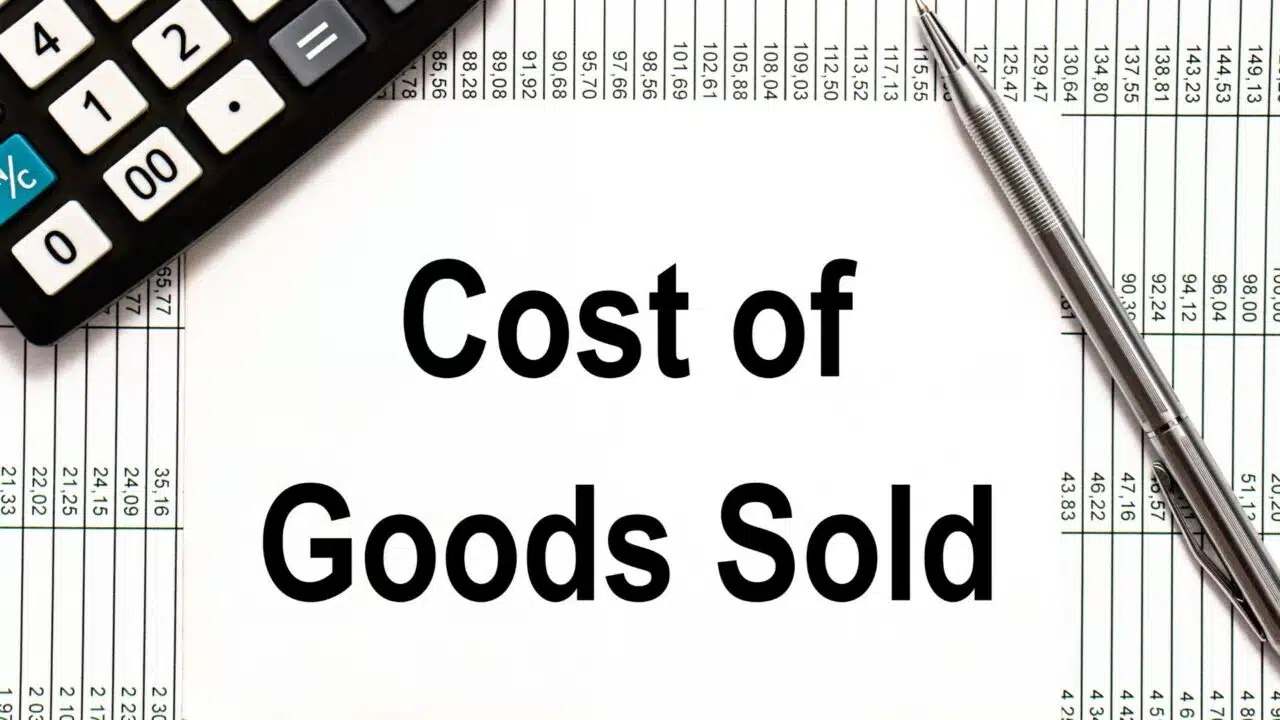Article Summary (TL;DR)
✅ Shopify COGS (Cost of Goods Sold) is crucial for profitability and pricing strategies.
✅ Accurate calculation and regular reporting of COGS help optimize inventory management and financial decision-making.
✅ Implementing COGS best practices can significantly improve your Shopify store’s overall performance and bottom line.
Knowing your Cost of Goods Sold, or COGS, is essential to figuring out how profitable your Shopify e-commerce site will be.
Making precise COGS calculations enables you to decide on pricing, marketing, and inventory strategies.
For your Shopify store, keeping track of your cost of goods sold (COGS) is essential since it provides valuable insights into the overall profitability and underlying financial health of your company.
The cost of goods sold (COGS) includes labor, shipping, raw materials, and other direct costs associated with the manufacturing of commodities.
You may learn more about the gross profit margins of each product in your Shopify store by closely monitoring COGS. This will help you make informed decisions about the prices of the products in your store.
This article will explain how to manage the Shopify cost of goods sold using best practices and how to obtain the COGS report.
What is Shopify COGS and Why is it Important?

The whole cost associated with creating and marketing a product is known as the cost of goods sold, or COGS.
This covers the price of labor, supplies, and any other direct expenses related to the production process. COGS is a key factor in figuring out your online store’s gross profit margin on Shopify.
Shopify users should take note of COGS since it provides insight into the actual cost of selling a goods.
You may evaluate your pricing strategy, ascertain the profitability of certain products, and even decide whether to continue or discontinue specific product lines by examining your Shopify COGS.
Additionally, you may precisely track the success of your online business by using Shopify’s COGS tracking feature.
You can spot patterns and trends in your Shopify COGS and, if necessary, take corrective action by closely monitoring them.
How Can Tracking Shopify COGS Boost Your Store’s Profitability?
By keeping track of COGS, you can determine the cost of each item sold and modify your pricing strategy accordingly.
This can therefore make your internet store more competitive in the marketplace, drawing in more clients and boosting revenue.
Furthermore, a precise Shopify COGS calculation provides you with inventory management insights.
By using this data, you can determine which products are not selling well or take up too much shelf space, and you can then make the necessary adjustments to your inventory.
Maintaining a close eye on your Shopify COGS can also help you uncover methods to cut costs, optimize your manufacturing processes, and ultimately increase the profitability of your Shopify store.
How Do I Calculate Shopify COGS (Shopify Cost of Goods Sold)?

You must compute the entire cost of manufacturing the products you sell in order to get your Shopify COGS.
To calculate Shopify COGS, simply multiply your inventory value at the beginning of the period (called Beginning Inventory) by the cost of purchases and divide the total by the end of the period (called Ending Inventory).
You must regularly monitor the prices you pay for each item in order to assess inventories for COGS. To accomplish this, go into Shopify and enable “Track inventory” for each product.
🗣️ Pro Tip: Every time you buy new merchandise, it’s critical to keep track of the price you paid.
Some companies calculate the total sum per unit of inventory using the weighted average approach, which involves dividing the entire cost of new inventory by the number of units.
Some calculate the value of remaining inventory using the LIFO (Last in, First out) or FIFO (First in, First out) methodologies.
It should be noted that although both LIFO and FIFO are permitted under US GAAP, LIFO is prohibited under International Financial Reporting Standards (IFRS).
To obtain an accurate picture of your Shopify COGS over time, the most crucial step is selecting an inventory valuation method and adhering to it regularly.
By keeping a close eye on every expense related to the acquisition and sale of your goods, you can determine the amount of cash and profit margin needed to run a long-term company.
The Formula
To simplify it further, here’s a breakdown of the formula you need to use:
Cost of Goods Sold = Beginning Inventory + Additional Inventory Purchased – Ending Inventory
To compute COGS, this formula considers the inventory value at the start of the period, any inventory that is purchased during the period, and the inventory value at the end of the period.
Are There Particular Variables Needed to Calculate Shopify COGS?

You must know the whole cost of the product, including all direct costs and expenses (such as labor, raw materials, and overhead) that went into manufacturing, in order to compute COGS on Shopify.
The price of shipping and any other costs associated with getting the product to the buyer should also be factored into this computation.
It’s imperative that you maintain a record of your inventory levels, encompassing both the initial and final inventory levels for each accounting period.
This will assist you in figuring out the overall cost of the products sold during that time.
Direct & Indirect Costs
The costs incurred directly in the production of a products or service are known as direct costs.
On the other hand, indirect costs are those regular business expenditures that are required to maintain your company’s operations.
Accurately calculating your Shopify COGS can be aided by understanding the cost category that each of your expenses belongs to.
Here’s a brief breakdown of each:
| Indirect Costs | Direct Costs |
|---|---|
| Maintenance, Utility, and Repairs | Conversion Costs |
| Other Factory Overhead Costs | Direct Labor Costs |
| Depreciation on Production Machinery | Raw Materials Used in Production |
| And More… | And More… |
Can You Utilize Shopify’s Accounting System to Calculate COGS?

With Shopify’s integrated accounting features, you can precisely track and compute Shopify COGS.
Using your Shopify account dashboard, navigate to the ‘Finance’ section, choose ‘Profit and Loss,’ and then click on ‘Cost of Goods Sold’ to access this option.
You may use this function to change inventory levels, set prices for each product in your store, and even export data to your accounting program for more analysis.
How to Setup Shopify COGS Tracking?
You must first activate inventory tracking for every product in Shopify before you can begin tracking COGS.
To keep an eye on stock levels and fulfillment expenses for every item, use the “Track inventory” and “Enable fulfillment service” options under the Product page.
You can then start entering data in the areas for inventory, purchases, and cost changes if these options are activated.
Enter the purchase price for each item of inventory that is currently in stock in the Inventory section. Use the Purchases box to record the specifics of your stock purchases, including the cost per unit.
To assist in determining beginning inventory for the upcoming period, the Purchases view maintains a running record of every inventory you have purchased.
🗣️ Pro Tip: Any modifications to your inventory’s costs can be monitored in the Cost Adjustments section over time.
Once you have cost and inventory information for every product, you can use Shopify’s COGS reports to examine your margins.
Product expenses, fulfillment fees, and the overall cost of goods sold as a proportion of revenue are just a few of the elements that are broken out and summarized in the Shopify Cost of Goods Sold report for a custom period.
To ascertain which products are the greatest sellers, the Product Profitability report combines revenue, costs, and inventory assessments.
These reports are essential for optimizing your revenue and inventory planning in light of potential future changes in expenses and sales.
How to Boost Profitability by Optimizing COGS on Shopify?

Optimizing your inventory levels on Shopify is one of the finest methods to reduce COGS. This entails modifying your inventory to precisely meet client demand, which lowers the quantity of waste and dead stock generated.
Additionally, you can lower manufacturing costs by locating suppliers at a lower cost or by streamlining and reducing waste in your production processes.
COGS on Shopify can be impacted by inventory levels in a number of ways. Overstocking your inventory, for instance, might lead to greater COGS due to increased storage and logistics costs.
However, having insufficient inventory on hand might also result in higher COGS. An increase in demand may cause a shortfall of supply, which may raise the cost of production and raise Shopify COGS.
Can You Use Analytics to Track COGS and Gross Profit Margin on Shopify?
Shopify offers an array of robust analytics tools to facilitate efficient tracking of your cost of goods sold and gross profit margin. Navigating to the ‘Analytics’ section of your Shopify account dashboard will get you access to these services.
This is where you can see detailed information on your sales, inventory, and customer behavior, which will help you understand how profitable your store is.
In order to stay competitive in the market, you may also utilize these analytics tools to precisely estimate demand, modify your marketing plans, and optimize your pricing.
Best Practices for Managing COGS in Shopify

To fully benefit from COGS tracking in Shopify, consider an accounting integration to connect Shopify with your accounting software.
This eliminates manual data entry, saving time and reducing errors, helping you maintain best practices in your Shopify store management.
It’s also critical to regularly check expenses in order to identify any inaccurate information or quantities.
Examine COGS reports on a weekly or monthly basis to track changes in costs and margins over time, as well as the goods that yield the most and least profit.
This will assist you in strategically adjusting inventory or price in light of the data. COGS reporting helps you manage your business effectively by showing you where you are and how to go profitably.
How to Reduce Your Shopify COGS
There are various strategies you might employ if your goal is to lower your e-commerce company’s cost of goods sold (COGS).
Reducing COGS may be more advantageous than boosting prices, depending on your unique situation (although you can evaluate both possibilities).
These are several key tactics, but keep in mind that not every one of them will work in your circumstance.
- Make use of economies of scale: As your store expands, look into the possibilities of securing discounts for larger purchases, whether you make your products yourself or procure them from a supplier.
- Find and fix errors: Anything that is impeding the expansion of your supply chain needs to be addressed. For example, you might find problems like materials that are broken, items that are missing after transportation, or inefficient labor. Take action to address these issues and improve the efficiency of your business.
- Optimize automation in your processes: As a provider of accounting integration solutions, we understand the value of automation. Automating tasks can be quite beneficial if labor expenses account for a large amount of your COGS. This could entail introducing software that improves the overall productivity of your staff or switching out manual processes with automated ones.
- Think about transferring suppliers: This also holds true for materials and manufacturers in general. It might be beneficial to look into other options if negotiating on the basis of economies of scale with your current business partners is not producing satisfactory results. This can entail looking into offshore production possibilities, choosing a supplier with cheaper shipping, or using less expensive materials in your manufacturing process.
- Examine which products aren’t selling well in order to assess product sales. If these products sit on your shelves unsold, even with a healthy profit margin, it could have a detrimental effect on your COGS. Try to find strategies to lower the rate of inventory turnover, or think about stopping certain products completely.
Final Thoughts
Understanding and effectively managing your Cost of Goods Sold (COGS) is crucial for the success of your Shopify store.
By accurately tracking and optimizing your COGS, you can make informed decisions about pricing, inventory management, and overall business strategy.
Remember these key points:
- Regularly monitor and calculate your COGS to maintain a clear picture of your store’s financial health.
- Utilize Shopify’s built-in tools and analytics to track COGS and gross profit margins effectively.
- Consider integrating your Shopify account with accounting software to streamline data management and reduce errors.
- Implement strategies to reduce COGS, such as leveraging economies of scale, optimizing processes, and evaluating supplier relationships.
- Continuously analyze your product lineup and eliminate underperforming items that negatively impact your COGS.
By mastering COGS management, you’ll be better equipped to boost your store’s profitability, make data-driven decisions, and stay competitive in the e-commerce marketplace.
Remember that COGS optimization is an ongoing process, so regularly review and adjust your strategies to ensure long-term success for your Shopify business.
Comments
Related Posts
Smart Guide to Import Amazon Data to Google Sheets
Running an Amazon business means juggling dozens of moving parts:…
The ultimate guide to Shopify marketing attribution: what works best for your business?
What you’ll learn Have you ever wondered where your customers…
Top 5 Strategies to Sustainable Shopify Growth: Turning One-Time Buyers into Lifetime Customers
What you’ll learn As a Shopify seller, you’re constantly looking…







Leave a Reply